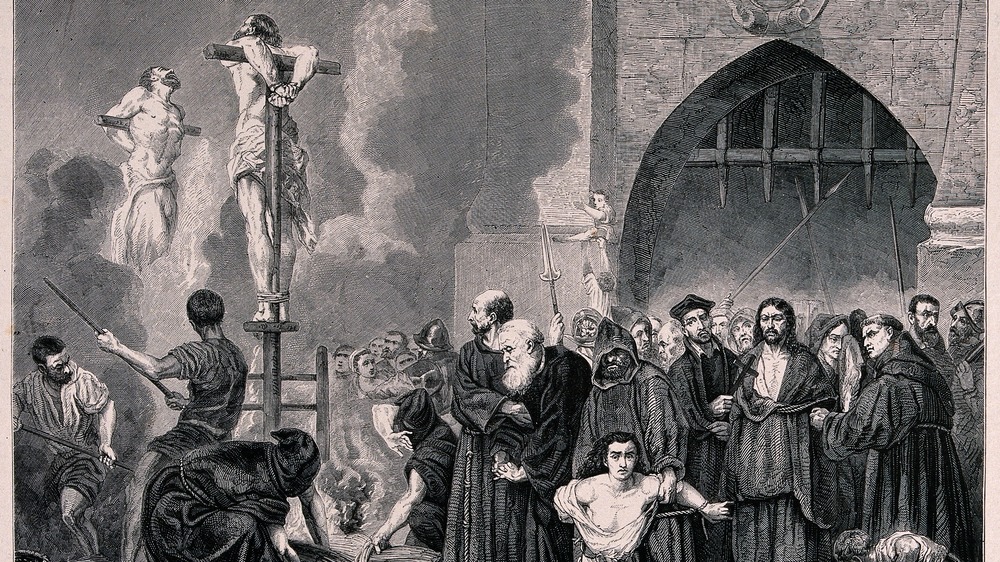This Papal Decree Made Black Cats Illegal
The human race definitely seems to have a love-hate relationship with cats. On one hand, cute cat videos practically formed the bedrock of early YouTube, what with their laser-pointer-chasing shenanigans, parkour jumps, cat-on-cat boxing, or just purring while being fluffy. On the other hand, some people think that cats are devils incarnate: clawed and fanged fear-balls that plot to assassinate you in your sleep, and in the meantime will push your glassware off the table while you watch.
And we all know the superstition about black cats: they're bad luck, don't let them cross your path, they go hand-in-hand with broomsticks and wart-nosed witches, and so on. They're basically the animal version of walking under a ladder.
As the Animal Emergency & Referral Center speculates, this association may have arisen during medieval times as urban-dwelling cats were taken in as creatures of comfort to the elderly or sick. When the sick person died, blam: it was definitely the cat and not a lack of acceptable hygiene. They also hunted at night, were difficult to see, and had glowing eyes. Fear of them grew in Spain during the 1500s, especially, as regional folklore included people who shape-shifted, as ScoopWhoop tells us. And if black cats weren't shape-shifters, then they were "familiars" that acted as a witch's eyes and ears. Heck, even Professor McGonagall in Harry Potter was an "animagus" who could change into a cat.
But could anyone dislike black cats so much that they put a death sentence on them?
The pope thought the devil was a half-cat creature
So who would order the assassination of a particular color of cuddly animal? Well, the same person who ordered the assassination of people who stepped on the authority of the Catholic Church: Pope Gregory IX, who, per Britannica, reigned from 1227-1241. Pope Gregory is credited with starting one of the Church's most bloodthirsty phases, the Inquisition, and not even common household pets could escape. The church set out to uncover hidden heresy and "demonic objects," as Feedsnitt tells us. Civilian houses were raided by those given papal authority — inquisitors — and their victims were subject to torture in order to extract information. Some of those found guilty were burned alive at the stake.
In 1233, one such inquisitor, Conrad of Marburg, claimed to have uncovered evidence of a satanic cult that worshiped a big black cat, as the World Heritage Encyclopedia (posted at Project Gutenberg) outlines. As a result, Gregory issued Vox in Rama, a papal decree. It condemned "Luciferians," provided detailed descriptions of supposed demonic rituals, and stated that black cats were the Devil incarnate, who himself was a "half-man, half-feline" creature.
The Church had such enormous power that no one dared defy them. This practice was not only followed, but it continued until the early 19th century, which is why, to this day, there are so few all-black cats in Western Europe.
Black cats get the last laugh
It turns out, though, that black cats would get the last laugh. Over 100 years after Vox in Rama, the most virulent plague of all time swept through Europe: The Black Death. From 1346-1353 it killed over 50 million people, as History Today tells us — about 60 percent of the population of Europe at the time. There were so many dead bodies that one Florentine said, "they took some earth and shoveled it down on top of them; and later others were placed on top of them and then another layer of earth, just as one makes lasagna with layers of pasta and cheese." Another historian from Tuscany said, "And there were also those who were so sparsely covered with earth that the dogs dragged them forth and devoured many bodies throughout the city."
The Black Death was carried from the northwestern shores of the Caspian Sea and into Europe through fleas on rats, and then the fleas jumped from rats to humans, especially in urban centers. People developed swollen, painful bubbles of fluid called bubo, which is why the Black Death is sometimes referred to as the Bubonic Plague. And because the church had conducted its black-cat-killing crusade, there weren't enough cats to catch all the rats.
Yet even today, when we most assuredly know better (or should), black cats still get a bad rap.


